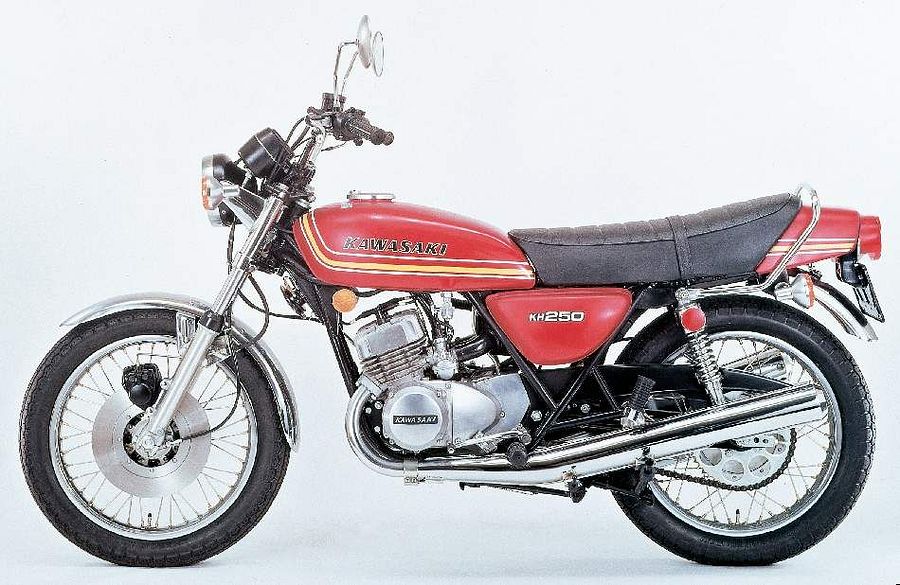Kawasaki KH250 (1976-77)
The Kawasaki KH 250 motorcycle was produced from 1976 to 1977 and has a two-stroke transverse three-cylinder engine with a capacity of 249 cc. Its air-cooling system and compression ratio of 7.5:1 are supported by ignition via CDI and a kick-start. The bike is powered by 28 horsepower at 7500 rpm and a maximum torque of 2.7 kgf-m at 7000 rpm. The KH 250 comes fitted with a 5-speed transmission and a chain driven final drive. Its frame is constructed with double tubular steel cradle, while its front suspension comprises telescopic hydraulic forks, and the rear suspension is equipped with dual shocks and a swing arm. The bike uses a single disc brake for its front brake and a 180mm drum for the rear brakes. It rides on 3.25-18 and 3.50-18 tires for its front and rear wheels, respectively. The bike is measured at 2020 mm in length, 820 mm in width, and has a wheelbase of 1374 mm with a ground clearance of 152 mm. It weighs in at 157 kg and has a fuel capacity of 14 liters with an average fuel consumption of 43 mpg. The Kawasaki KH 250 can complete a quarter-mile standing in 15.8 seconds and has a top speed of 90 mph.
Technical specifications:
Make Model: Kawasaki KH 250
Year: 1976 – 77
Engine: Two stroke, transverse three cylinder,
Capacity: 249 cc / 15.2 cu-in
Bore x Stroke: 45 52.3 mm
Cooling System: Air cooled
Compression Ratio: 7.5:1
Induction: 3x Mikuni VM22SC, 22 mm carburetor
Ignition: CDI
Starting: Kick
Max Power: 28 hp @7500 rpm
Max Torque: 2.7 kgf-m / @ 7000 rpm
Transmission: 5 Speed
Final Drive: Chain
Frame: Double tubular steel cradle
Front Suspension: Telescopic hydraulic forks
Rear Suspension: Dual shocks, swingarm
Front Brakes: Single disc
Rear Brakes: 180mm Drum
Front Tyre: 3.25-18
Rear Tyre: 3.50-18
Dimensions: Length 2020 mm / 79.5 in Width 820 mm / 32.3 in
Wheelbase: 1374 mm / 54.1 in
Ground Clearance: 152 mm / 6.0 in
Dry Weight /: 157 kg / 348 lbs
Fuel Capacity: 14 Litres / 3.7 US gal
Consumption Average: 43 mpg
Standing 1/4 Mile: 15.8 sec
Top Speed: 90 mph
Related models:
- Kawasaki Z440C (1979)

- Kawasaki GPZ250R (1986)



- kawasaki Ninja 400 (2017-18)



- Kawasaki KLX 450R (2012)



- Kawasaki Ninja H2 ZX 1000 (2016)



- Kawasaki VN 700 Vulcan (1986-90)



- Kawasaki Z750 (2011-12)



- Kawasaki VN1700 Voyage se (2015)



- Kawasaki ZZR1400 (2010)



- Kawasaki ZX10 (1988)



- Kawasaki KH250 (1980-81)



- Kawasaki KDX450 (1980-82)



- Kawasaki BJ250 Estela (2000-06)



- kawasaki Ninja 400 (2015)



- Kawasaki Z300 (2015-16)



- Kawasaki ZZR400 (1990-91)



- kawasaki KLE500 (1993-95)



- Kawasaki KLR 600 (1986-87)































